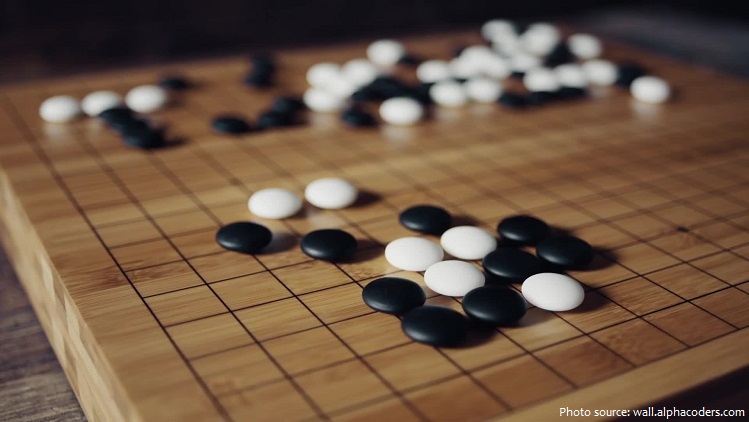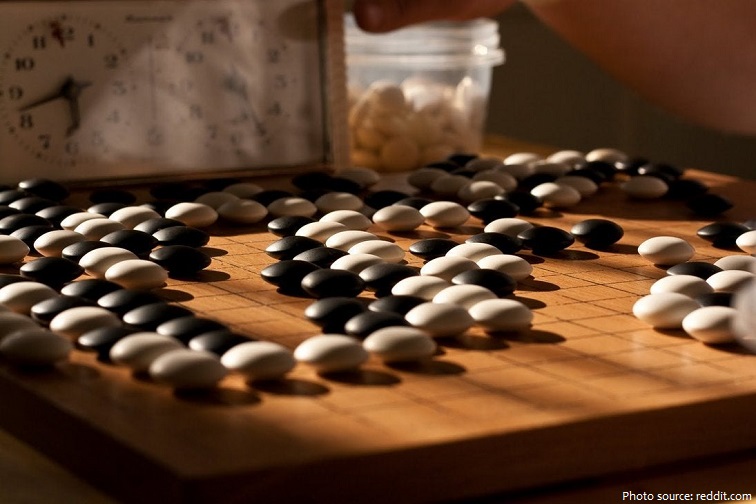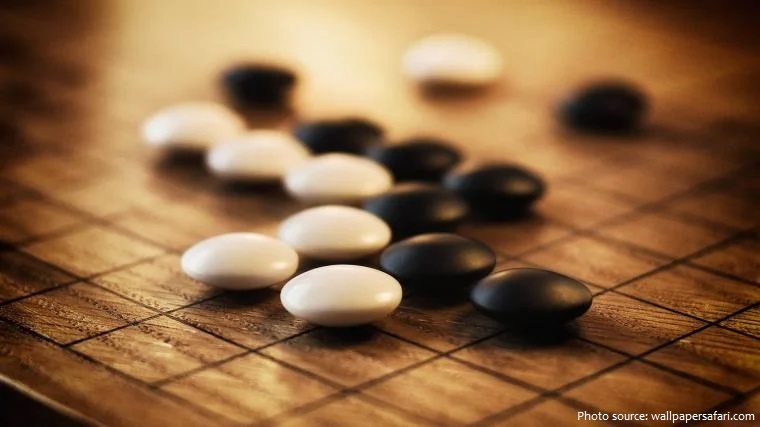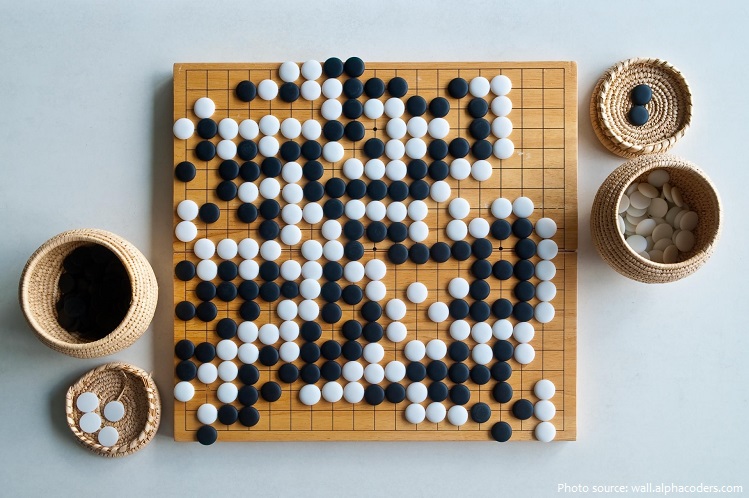
Go or Weiqi, Weichi is an abstract strategy board game for two players in which the aim is to surround more territory than the opponent.
A game so complex it contains more possible moves than the total number of atoms in the observable universe, Go is also the oldest surviving board game.
Traditionally, go is played with 181 black and 180 white go-ishi -flat, round pieces called stones – on a square wooden board (goban) checkered by 19 vertical lines and 19 horizontal lines to form 361 intersections.

The players take turns placing the stones on the vacant intersections (points) of a board. Once placed on the board, stones may not be moved, but stones are removed from the board if the stone (or group of stones) is surrounded by opposing stones on all orthogonally-adjacent points, in which case the stone is captured. The game proceeds until neither player wishes to make another move. When a game concludes, the winner is determined by counting each player’s surrounded territory along with captured stones and komi (points added to the score of the player with the white stones as compensation for playing second). Games may also be terminated by resignation.
Of East Asian origin, it is popular in China, Korea, and especially Japan, the country with which it is most closely identified.

The word “Go” is a short form of the Japanese word igo, which derives from earlier wigo, in turn from Middle Chinese ɦʉi gi – Mandarin: wéiqí, lit. ’encirclement board game’ or ‘board game of surrounding’.
In English, the name “Go” when used for the game is often capitalized to differentiate it from the common word go. In events sponsored by the Ing Chang-ki Foundation, it is spelled goe.
The earliest written reference to the game is generally recognized as the historical annal Zuo Zhuan (c. 4th century BC), referring to a historical event of 548 BC. It is also mentioned in Book XVII of the Analects of Confucius and in two books written by Mencius (c. 3rd century BC).
In China, Go was considered one of the four cultivated arts of the Chinese scholar gentleman, along with calligraphy, painting and playing the musical instrument guqin In ancient times the rules of go were passed on verbally, rather than being written down.

Go was introduced to Korea sometime between the 5th and 7th centuries AD, and was popular among the higher classes. In Korea, the game is called baduk, and a variant of the game called Sunjang baduk was developed by the 16th century.
The game was probably taken to Japan about 500 AD, and it became popular during the Heian period (794–1185). The modern game began to emerge in Japan with the subsequent rise of the warrior (samurai) class.
It was given special status there during the Tokugawa period (1603–1867), when four highly competitive go schools were set up and supported by the government and go playing was thus established as a profession
The game became highly popular in Japan in the first half of the 20th century – it was also played in China and Korea, and its following grew there in the latter decades of the century.

Despite its widespread popularity in East Asia, Go has been slow to spread to the rest of the world.
The first recorded game of Go in Europe was played in 1872 between Kido Takayoshi and Ōkubo Toshimichi. Both were vice ambassadors of the Iwakura Mission, which traveled to the United States and Europe between 1871 and 1873.
In the 20th century, Go had spread throughout the German and Austro-Hungarian empires. In 1905, Edward Lasker learned the game while in Berlin. When he moved to New York, Lasker founded the New York Go Club together with (amongst others) Arthur Smith, who had learned of the game in Japan while touring the East and had published the book The Game of Go in 1908. Lasker’s book Go and Go-moku (1934) helped spread the game throughout the US, and in 1935, the American Go Association was formed.

World War II put a stop to most Go activity, since it was a game coming from Japan, but after the war, Go continued to spread. For most of the 20th century, the Japan Go Association (Nihon Ki-in) played a leading role in spreading Go outside East Asia by publishing the English-language magazine Go Review in the 1960s, establishing Go centers in the US, Europe and South America, and often sending professional teachers on tour to Western nations. Internationally, the game had been commonly known since the start of the twentieth century by its shortened Japanese name, and terms for common Go concepts are derived from their Japanese pronunciation.
The game remains popular to this day and was briefly a hot topic during 2016, when Google’s AlphaGo computer program beat the world’s top-ranked Go player, Lee Sedol. Thanks to its near-infinite possibilities, Go cannot be mastered by simple analytical thought. Instead, players must take an intuitive approach based on pattern recognition. Therefore, AlphaGo’s victory signals a major step forward for Artificial Intelligence. What was developed over thousands of years of artful mastery was beaten in a day by a computer.
Top Go players in countries like China, Korea, and Japan can enjoy international celebrity status, the same way Gary Kasparov is synonymous with chess – through the pool of Go celebrities is rather deeper than that of chess, which is a testament to how celebrated this board game is in the Asia region.
